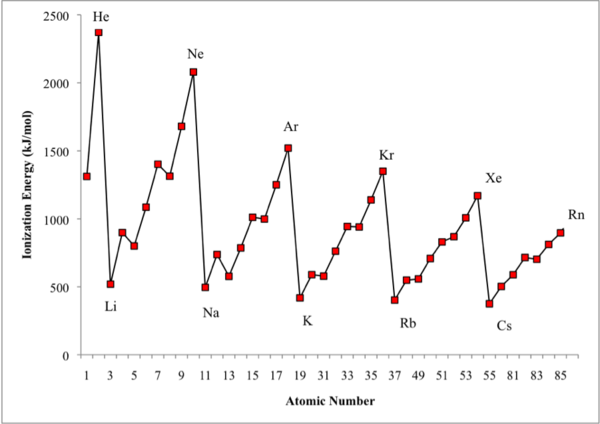| << Chapter < Page | Chapter >> Page > |
The experimental data found from measuring the ionization energies of the elements are shown in the graph in [link] .

The first thing to notice in [link] is that the Periodic Law definitely applies to this particular property of the atoms. As we look at the atoms with increasing atomic number, the ionization energies increase and then abruptly decrease, over and over. At the top of each peak sits a noble gas element. At the bottom of each valley sits an alkali metal. Between each alkali metal and the next noble gas, the ionization energies increase almost continuously, with only small breaks along the way. This is a great confirmation of the Periodic Law.
In this case, we can actually start to understand the patterns in [link] from thinking about Coulomb’s Law. The easiest property to understand is that in each period in the figure, the ionization energy increases as we move from an alkali metal (like Li) to the next noble gas (like Ne). This makes sense in terms of Coulomb’s Law, because the atomic number, Z, is increasing, so the nuclear charge is increasing, so the electrons are more strongly attracted to the nucleus as Z increases.
If we follow this line of thinking, we might expect that the ionization energies would just constantly increase with increasing atomic number Z . But this is not observed. Instead, after each noble gas, the ionization energy drops very dramatically to the following alkali metal (as in going from Ne to Na). Looking at the equation for Coulomb’s Law, how can it be that a larger value of Z from Na compared to Ne can result in a much, much smaller ionization energy?
The answer is in the denominator of Coulomb’s Law, the distance r . The only way for the ionization energy to get smaller when Z gets larger is for r to get larger as well. In fact, r has to get much larger since the ionization energy falls by such a large amount. This means that the electron which is ionized in Na is much farther from the Na nucleus than the electron in Ne which is ionized is from the Ne nucleus.
Perhaps this means that r just increases smoothly as the atomic number gets larger. But the data do not show this at all. After Na, the ionization energies of the atoms continue to grow again with the increasing atomic number, Z, and the larger charge of the nucleus.
Putting these two conclusions together, we can create a model of the atom that explains the Periodic Law and the Ionization Energies in [link] . In each period of the Periodic Table from an alkali metal to a noble gas, the outermost electrons are all about the same distance from the nucleus. Each additional electron in each atom in one period is added to this same “layer” of electrons, which we will call an “electron shell.” At the end of the period, the shell is apparently full and unable to accommodate any more electrons. The next added electron in the next period must be in a new shell, much farther from the nucleus.
It is worth reviewing how this “shell” model of the atom’s structure explains the pattern in the ionization energies in [link] . This is left as a discussion question. Beyond that, though, there is an explanation for the Periodic Law. Why, for example, do the alkali metals Li, Na, and K, have such similar properties? The answer from our shell model is that each of these atoms has a single electron in its outermost shell, even though they have very different numbers of electrons in total. That outermost electron is the one which must determine the chemical behavior of the atom. Similarly, F and Cl have very similar chemical properties because, from the data in [link] , we can tell that each of these types of atoms have 7 electrons in the outermost shell. Again, the number of electrons in the outermost shell of the atom appears to determine the atom’s chemical and physical properties.

Notification Switch
Would you like to follow the 'Concept development studies in chemistry 2013' conversation and receive update notifications?